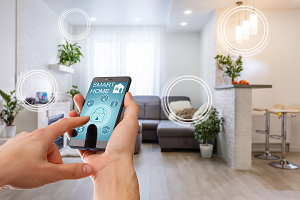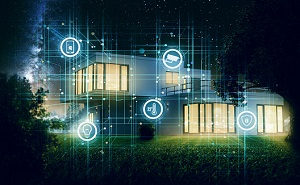With the maturity and integration of technologies such as AI, big data, IoT, cloud computing, and 5G, our lives have become more comfortable, convenient, and efficient in the 21st century. Artificial intelligence has already occurred in many aspects of our lives. incredible change. Home is a warm harbor. After a busy day, people can really relax when they return home. People will spend more than half of their life at home. With the continuous development of society, the design of home space should keep pace with the times. The introduction of artificial intelligence into the home space will be the trend of interior design in the new era, and it is also a modern embodiment of the principle of people-oriented design in space design.
Since the day of human birth, the pursuit of high-quality life has never stopped. From the use of stone tools in the Paleolithic Age to now everyone has a smartphone; from sitting on the floor to the classic furniture of the Ming Dynasty to the current smart massage chair; from the formation of gregarious caves to the formation of settlements to the current high-rise buildings, human beings are constantly realizing in various fields. new transcendence.

The continuous maturity of current computer network technology, modern communication, AR virtual reality, face recognition, fingerprint recognition, voice recognition, modern intelligence, and other technologies has changed our lives in various aspects. The ultimate goal of scientific and technological progress is to serve mankind. The average life expectancy of human beings is calculated at the current stage of 78 years, and the time spent at home sleeping in a person's life will take up 1/3. That is 26 years, plus the time for daily life and leisure and entertainment, people are in The time spent at home will be more than half. Therefore, it is of great research and practical significance to explore intelligent design in home space.
1. The concept of a smart home
The world's earliest research on smart homes can be traced back to the United States in the 1980s, when the building's air conditioning, elevators, lighting, and other equipment were monitored in the renovation of some old buildings, providing the building with some simple Communication service. After that, some economically developed countries such as Canada, Australia, and Singapore have also successively explored the field of smart home design. Smart homes are widely used in the United States, Germany, Spain, Japan, and other countries. The "House of the Future" established by Bill Gates in 1990 is fully compatible with the concept of a smart home. Not only is it connected to the Internet, but all doors, windows, lamps, and electrical equipment can be controlled by a computer. It is called a Smart home and is the prototype of a modern smart home.
In the residential space, the smart home integrates architecture, household appliances, network communication, and equipment automation as well as system structure, service, and management. It uses integrated wiring technology, network communication technology, security technology, automatic control technology, and audio and video technology to integrate home furnishing. Integrate life-related facilities, build an efficient management system for residential facilities and family schedule affairs, improve home safety, convenience, comfort, and artistry, and achieve an environmentally friendly and energy-saving living environment; intelligently integrate home use through the Internet of Things technology and mobile Internet. Electrical appliances or equipment are connected together to provide various functions and means such as security control, lighting control, water and electricity control, network control, and health monitoring, providing an efficient, comfortable, safe, convenient, and environmentally friendly home space environment.
2. Application of smart home in indoor space
As mentioned above, more than half of a person's life is spent at home on average, so how can contemporary interior design build an ideal smart home based on contemporary technology, so that people can share the fruits of technological development in the home space? The intelligent needs in the space mainly include access control security intelligence, lighting intelligence, home appliance intelligence, health and hygiene intelligence, and emotional intelligence, which are as follows:
2.1 Access control security intelligence
The smart door connects with the smart host through voice and iris technology or face recognition, and transmits the information to the mobile phone, tablet or computer through the network, and the smart door identifies the owner through the above recognition technology. The specific manifestations are: (1) When the intelligent system recognizes the owner's information, it issues an instruction: a language prompt such as "Welcome the owner home", the door will be opened immediately to welcome the owner home; (2) When outsiders or strangers need to enter When the door is opened, the smart door transmits the information to the smart host, and the smart host transmits the information to the mobile phone through the network. The owner can complete the remote call with the outsiders through the mobile phone or tablet computer, and can enter with permission; (3) The window is installed with infrared sensors devices such as sensors and sensors, and connect with smart hosts. If the wind and rain strike, the windows will be closed automatically; (4) If a stranger or thief breaks in by force, the system will transmit the information to the mobile phone to remind the owner and issue an alarm.
2.2 Lighting intelligence
Lighting intelligence is the intelligent opening of lamps in the home space through the induction of light and the capture of characters. When the light is relatively strong during the day, it will be automatically turned off; in the case of insufficient light on cloudy and rainy days, the lamp will be turned on intelligently through infrared sensing; when the person leaves the radiation range of the lamp, the lamp will be automatically turned off. Environmental protection, energy saving, and humanization. The lamps in the bedroom and bathroom can be set in various modes. When the owner goes to sleep, the lamp automatically enters sleep mode; when the owner wakes up at night, the device slowly turns on the weak and soft light, so as not to make your eyes feel uncomfortable under the dazzling white light under the drowsiness; when the need for normal When lighting, the lighting mode can be switched by voice.
2.3 Smart Home Appliances
Home appliances refer to TVs, refrigerators, washing machines, air conditioners, and other main appliances in the home, and home appliance intelligence is to make home appliances intelligent. The TV can be turned on and off by voice, you can use voice to find the channel or program you want to watch, and you can use gestures, eyes, and distance to interact with the TV; when people leave the TV and no one is watching, the TV Automatically enters the standby state or automatically turn off, no longer have to worry about finding the remote control and achieve the purpose of energy saving. The air conditioner can be adjusted automatically through human behavior and the overall space temperature, rather than the current manual adjustment through the remote control. No more worrying about being woken up at night and touching the remote control reluctantly. When the owner of the space leaves for a period of time, the air conditioner will automatically turn off, so there is no need to worry about leaving the house without turning off the air conditioner!

2.4 Health and hygiene intelligence
Health and hygiene intelligence will be paid more and more attention to in the design of home space. Install ultraviolet sterilization equipment in the home space, automatically detect harmful germs in the home space through the detection system, transmit the information to the smart host, and the smart host transmits the information to the mobile phone or tablet. Through remote control to turn on the ultraviolet system, the whole space is disinfected and sterilized, so as to protect the health of the family. The smart toilet at home is also a detection machine. After detecting and analyzing the feces and urine, it sends the relevant parameters to the mobile phone to remind the owner to pay attention to health. For example, one day the hostess finished using the toilet, and the "Pony" warmly reminded: congratulations to the host for being pregnant. Robot vacuum cleaners have been around for a long time. Equipping a robot vacuum cleaner in your home will save you a lot of trouble. When you are on your way to and from get off work, you can remotely control the smart sweeping robot to clean your home by operating a mobile phone. When a fault occurs, the information is transmitted to the mobile APP. The owner can realize remote adjustment through home monitoring, complete the cleaning work, and keep the home clean and hygienic.
2.5 Emotional Intelligence
Emotional intelligence is not a separate intelligence but is integrated into the various intelligent needs of the home space. In health and hygiene intelligence, when it detects that the owner's health indicators are abnormal, it will send relevant precautions to the owner's mobile phone and give voice prompts. In the emotional design of the smart home, the following principles are mainly followed. (1) Humanized interactive experience. While people's material life is steadily improving, their demands for emotions are also getting higher and higher. In the process of smart home design, people's interactive actions and behaviors should be combined to awaken people's emotions. For example, the access control security intelligence mentioned above, when the host is standing outside the house, the access control intelligence will say to the host, "The host has worked hard, welcome the host home", and then the door will automatically open; on weekends, it will also remind the host "Tomorrow weekend Do you want to get up later?" and other warm instructions with emotion. (2) Situation simulation naturalization. When designing smart homes, it is necessary to target different customer groups, consider the living habits and individual differences of users, and reflect the particularity, naturalness, and authenticity of the design. This in turn enhances the user's sense of participation and recognition of the product. For example: in the bedroom, when the host is busy lately, it will prompt the host to "it's very late, rest early" and other warm instructions in natural situations. (3) Agile information processing. In the process of smart home design, the effective application of modern technologies such as big data and cloud computing is used to collect information quickly and accurately to provide users with accurate services. (4) System opening and security. The security design of smart homes is particularly important. Because smart homes provide users with an open communication environment, which is conducive to information sharing and interaction, but there are also security risks, it is necessary to further strengthen security design, such as video surveillance, access control, etc. to ensure the safety of users. (5) Efficient utilization of space. From the perspective of purpose, a smart home is mainly to provide people with a comfortable and convenient living environment. Automation technology can effectively improve the efficiency of space use. Users can choose different services according to their own needs to achieve a better emotional experience.
In the emotional design of the smart home, it is necessary to consider the influence of various factors and follow the above five principles to ensure the applicability, scientificity, and rationality of the smart home, provide people with better smart home products and promote smart home Healthy, stable and rapid development
You may want to know:The Best Smart Home Devices for 2022











